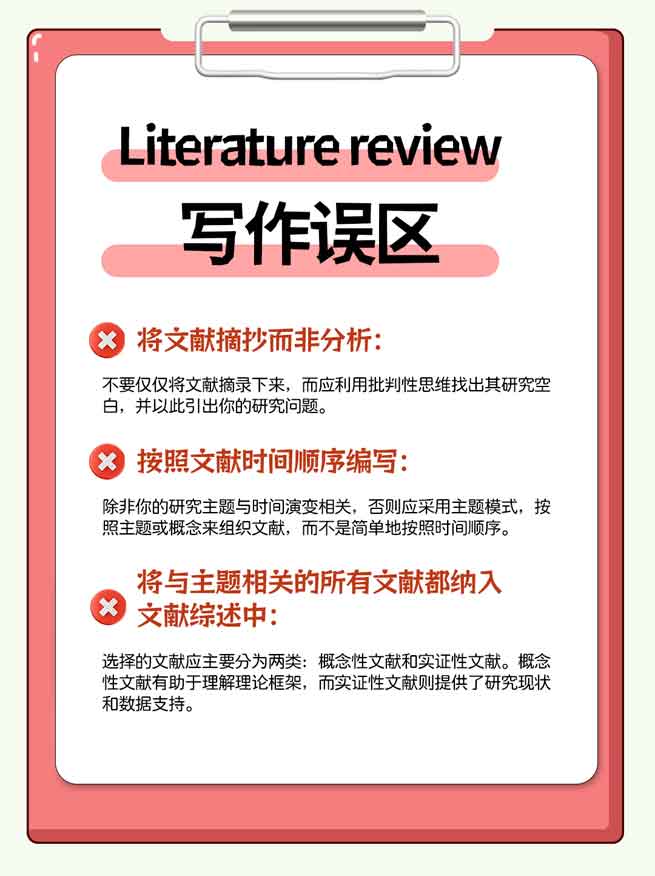

LR包含内容
LR五大步骤
LR写作误区
LR模板句型
研究背景和意义:介绍研究领域的背景,解释为什么该领域的研究是重要的,以及您的研究将如何填补现有知识的空白或解决现有问题。
研究现状:对已有文献进行梳理和总结,包括主要观点、理论、研究方法和发现。这部分通常会将相关文献按照主题或概念进行组织,并指出不同研究之间的一致性和分歧。
研究空白和限制:识别并讨论已有研究中存在的空白、不足或局限性,指出这些空白和限制为什么是重要的,并解释您的研究将如何填补这些空白或解决这些限制。
概念框架:介绍和解释与您的研究相关的关键概念、理论或模型,确立研究的理论基础。
研究方法:讨论已有研究所采用的方法,并评价其优缺点,指出您选择的研究方法以及选择该方法的理由。
结论和展望:总结文献综述的主要发现,强调研究的重要性,并提出未来研究的方向和建议。
1. 确定研究方向:明确您感兴趣的研究领域或主题,并确定研究问题。
2. 收集文献:广泛搜集与您研究主题相关的文献,包括期刊文章、学术书籍、会议论文等。
3. 文献筛选:对收集到的文献进行筛选,根据其与研究主题的相关性、质量以及适用性等标准进行评估,保留最相关和高质量的文献。
4. 识别研究空白和限制:在文献综述中识别出已有研究中的空白或限制,并强调您的研究将如何填补这些空白或解决这些限制。
5. 写作框架:
撰写文献综述时,可以采用以下框架:
研究背景和意义:介绍研究领域的背景和研究的重要性。
研究现状:综述已有研究的主要发现和观点。
研究空白:指出已有研究中存在的空白或不足之处。
概念框架:介绍相关概念和理论框架。
研究方法:讨论已有研究所采用的方法,并评价其优缺点。
结论和展望:总结已有研究的主要发现,并指出未来研究的方向和建议。

❌ 将文献摘抄而非分析:不要仅仅将文献摘录下来,而应利用批判性思维找出其研究空白,并以此引出你的研究问题。
❌ 按照文献时间顺序编写:除非你的研究主题与时间演变相关,否则应采用主题模式,按照主题或概念来组织文献,而不是简单地按照时间顺序。
❌ 将与主题相关的所有文献都纳入文献综述中:选择的文献应主要分为两类:概念性文献和实证性文献。概念性文献有助于理解理论框架,而实证性文献则提供了研究现状和数据支持。
1. Introduction and Research Background:
· "Over the past few decades, research on [research topic] has become an integral part of [field] studies."
· "In the current landscape of [field] research, there is a growing interest in [research topic], as evidenced by the increasing number of academic publications."
· "As the importance of [research topic] in [field] becomes increasingly apparent, research on this topic has become more prevalent."
2. Summarizing Existing Research:
· "The majority of studies indicate that [summarize the main points or conclusions of existing research]."
· "Research on [research topic] has made significant progress, primarily focusing on [list the topics or areas of existing research]."
· "Studies on [research topic] exhibit diverse viewpoints and methodologies, including [listing the methods or theories employed in existing research]."
3. Identifying Research Gaps:
· "While significant progress has been made in existing research, there are still important research gaps that need to be addressed."
· "There remain unresolved issues in current research, such as [listing the unresolved issues in existing research], providing opportunities for further investigation."
· "Despite notable achievements in certain aspects of existing research, there is still a lack of comprehensive and in-depth understanding of [research topic]."
4. Emphasizing the Importance of the Study:
· "Addressing these research gaps is crucial for advancing the field of [research topic], providing guidance for practice, and driving academic research forward."
· "Resolving these unresolved issues is essential for gaining a better understanding of the essence of [research topic] and positively impacting the development of [field]."
· "By delving deeper into these issues, we can offer new perspectives and methodologies for the study of [research topic], providing valuable insights for both academia and practice."




